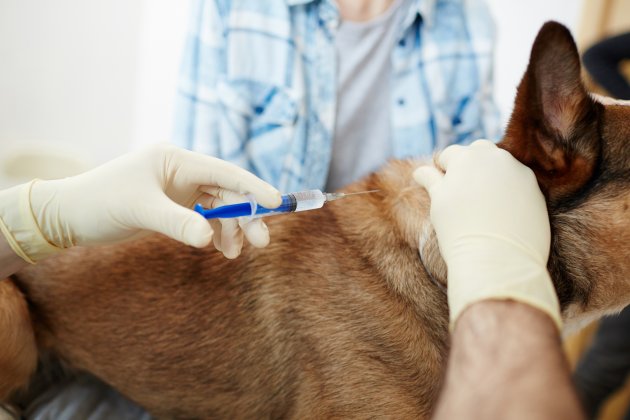Just the thought of parting from a beloved dog is heart-wrenching, and to make that final decision is the most difficult thing a pet owner has to do. But part of truly loving your pet is saving them unnecessary suffering.
Whilst we all wish a sick or frail pet would pass peacefully in their sleep, this rarely happens. Instead, caring owners need to do the unselfish thing by saying that final “Goodbye” at the right time.
This article takes a down-to-earth look at:
- Knowing when the time is right
- Planning for a peaceful passing
- The procedure of euthanasia
- Being there for your dog
The Right Decision at the Right Time
It is a dog’s only fault that they don’t live as long as we do. Therefore, it is almost an inevitability that devoted owners need to consider euthanasia at some point. Nothing about this decision is easy but remember: It’s quality of life that matters, not quantity.
Try to take a step back and be objective about the pet’s quality of life. It can help to take a piece of paper and list the following points:
- How is their appetite?
- Are they sick regularly or have diarrhea?
- How far can they walk and enjoy it?
- Do they still play?
- Do they do their usual things, like greet your homecoming?
- Are they pain-free?
- Can they control bladder and/or bowels?
- Do they enjoy good health?
Think about these points honestly and score each out of 10 (where 10 is good and 0 is poor.) How do the scores tot up?
Lots of high scores are encouraging, but a low number means the pet is struggling. If you are still undecided, then repeat this assessment in a few days, and see if anything has changed.
Also, listen to friends and family. They may not be as emotionally attached to the dog and notice things you aren’t able to.

Preparing for Euthanasia
Once the decision is made, preparing the family and planning the practicalities makes for a pleasanter passing.
Be Honest with Children
Talk to your children with gentle honestly, in words they understand. This gives the child a chance to be upset, which in turn helps them comes to terms with the loss.
Encourage children to express how much the dog means to them. This may be drawing the dog a picture, writing them a poem, or simply telling them they are loved. Yes, there may be tears, but you are there to comfort them and help the child adjust.
Plan these emotional goodbyes ahead of the actual procedure. The euthanasia itself should be about the dog’s needs, and you won’t be able to comfort both the dog and a child at the same time.
Planning the Euthanasia
Decide between the vet visiting the home or taking the dog to their office. Both options have pros and cons.
Home Visits
PROS:
- No loading the dog into the car for a final time
- Avoids the stress of visiting a place the dog dislikes
- A peaceful passing in a familiar environment
CONS:
- Can involve a lot of waiting around for the vet to arrive
- Not all dogs appreciate strangers coming into their home
- Can be expensive
Visiting the Vet’s Office
PROS:
- The vet has their team and equipment around them to ensure a smooth passing
- Can be less distressing for an owner in the long term, than regularly seeing reminders of the euthanasia at home
- Most clinics book euthanasia when the waiting room is empty and calm
- Less expensive
CONS:
- Vet clinics can be noisy, busy places at times
- Fewer home comforts
- The dog may not like visiting the vets at the best of times
Other Practicalities
Hard as it is to think beyond the euthanasia, the vet will need to know whether you want to bury the pet at home or opt for euthanasia.

Pet crematoriums offer a range of services, including individual cremations. This means the dog’s remains are returned to you, either in a scatter box or a casket (depending on your preference.) Alternatively, the dog will be cremated with others and their ashes scattered in a memorial garden at the crematorium
If you are able to tell the vet your wishes in advance, this is one less thing to cope with on the day.
What Happens During Euthanasia?
If this is your first experience of pet euthanasia, it is reassuring to know what to expect.
If your dog is prone to anxiety, let the vet know. They may suggest giving a gentle sedative, so the dog stays calm and relaxed. The vet may then place a catheter into a vein, usually in a front leg. The catheter is a portal via which the final injection is given. With this in place, you are better able to hold or cuddle the dog.
When everyone is prepared, the final injection is given. This is a concentrated barbiturate, pentobarbitone, and the equivalent of a lethal dose of an anesthetic. The dog merely feels sleepy, slips into unconsciousness, their heart and brain stop, and they pass away.
After passing, as the air cools in the lungs, some dogs appear to take a breath. This is nothing to be alarmed about and merely a muscular reflex. Your vet will carefully check to ensure there is no heartbeat, pulse, or other signs of life, and tell you when death has occurred.
You may then wish to spend time with your deceased fur-friend, to say those final goodbyes.
Ensuring a Pleasant Passing
To help your beloved pet have a peaceful passing, it may be helpful to be aware of the following:
- When booking the appointment, let the clinic know it’s for euthanasia. This allows the receptionist to arrange a quiet time with fewer people around and the vet isn’t pushed for time
- Have friends and family say goodbye at home. During the actual procedure, it’s best if one or two well-wishers present. Large crowds of emotional people are liable to confuse and distress the dog.
- Bring along a blanket for the dog to lie on and be comforted by, plus a favorite toy. This can accompany them afterwards (Once over the Rainbow Bridge, dogs love to play.)
- Focus on the dog and their needs. Yes, this is a hugely emotional time, but try not to let the dog see how distressed you are, as this will upset them.
And finally, be comforted that by putting the dog’s needs first you acted selflessly. You saved them suffering and by such self-sacrifice gave them a dignified end, to live-on in your memory forever.